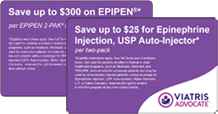
What is anaphylaxis?
Anaphylaxis is a severe systemic allergic reaction resulting from exposure to allergens that is rapid in onset and can result in a life-threatening emergency.1,2 Anaphylaxis is unpredictable and can cause stressful conditions — presenting unique challenges to healthcare partners, including school nurses, pharmacists and ER physicians.3-6
Anaphylaxis triggers
Anaphylaxis is triggered by a wide range of allergens, including, but not limited to, foods, insect stings and bites, medications and latex.1,2,4 While less common, anaphylactic reactions can also be triggered by exercise.1,4 When no allergic triggers for an anaphylactic reaction can be identified, a diagnosis of idiopathic anaphylaxis is made.1,4 Anaphylaxis usually occurs outside the presence of healthcare professionals and thus poses a serious health consequence if patients at increased risk are not identified and prepared.1,2,6,7 If patients are appropriately prepared, anaphylaxis is a largely preventable condition — though for some it is long-term risk.6
The continuum of anaphylaxis
The progression of anaphylaxis is not absolute.4 The signs and symptoms can arise within minutes of exposure to an allergen but can also develop 30 minutes or more after exposure.1,4 Moreover, symptoms that do not initially appear to be life threatening may progress rapidly unless proper treatment is given immediately.1,4
Protracted allergic reactions may warrant a second dose of epinephrine.
Epinephrine takes effect within minutes, but it is rapidly metabolized.3 As a result, its effect may be short-lived and repeated dosing may be necessary.3 In cases of a protracted allergic reaction—a reaction that can last for hours or even days despite initial treatment—a second dose may be required.3,4 The National Institute of Allergy and Infectious Diseases (NIAID) food allergy guidelines recommend that all patients at increased risk for, or who have experienced, anaphylaxis have access to two doses of epinephrine at all times.3 More than two sequential doses of epinephrine should only be administered under direct medical supervision.8,9
Biphasic reactions may occur.
In some cases, a second allergic reaction occurs 1 to 72 hours (usually within 8 hours) after initial recovery despite no further exposure to the trigger.1,4,10 This is known as a biphasic reaction, and it can occur in up to 20% of all anaphylactic reactions.1,10 Because biphasic reactions are unpredictable (even while administering immunotherapy), it is important that observation periods in the office be individualized for each patient.4,6 It is also important that patients at increased risk for anaphylaxis carry 2 doses of epinephrine.3,11
In this section:
- The first step in an anaphylaxis action plan is avoiding anaphylaxis triggers
- Take a deeper dive into the topic of identifying anaphylaxis
- Learn about immediate intervention tactics for managing anaphylaxis
- What you need to know about the potential risks of SCIT and SLIT
Explore
Viatris offers Access and Savings Programs for eligible patients. See Terms and Conditions.
There’s only one recommended first-line treatment for anaphylaxis.
heading
Important Safety Information (the following information applies to both EPIPEN and its Authorized Generic)
EPIPEN (epinephrine injection, USP) 0.3 mg and EPIPEN JR (epinephrine injection, USP) 0.15 mg Auto-Injectors are intended for immediate administration as emergency supportive therapy only and are not intended as a substitute for immediate medical or hospital care. In conjunction with the administration of epinephrine, the patient should seek immediate medical or hospital care. More than two sequential doses of epinephrine should only be administered under direct medical supervision.
Rare cases of serious skin and soft tissue infections have been reported following epinephrine injection.
References
- Simons FE. Anaphylaxis. J Allergy Clin Immunol. 2010;125(2)(suppl 2):S161-S181.
- Volcheck GW. Clinical Allergy: Diagnosis and Management. Rochester, MN: Mayo Foundation for Medical Education and Research; 2009.
- Boyce JA, Assa’ad A, Burks AW, et al. Guidelines for the diagnosis and management of food allergy in the United States: report of the NIAID-sponsored expert panel. J Allergy Clin Immunol. 2010;126(6 suppl):S1-S58.
- Lieberman P, Nicklas RA, Randolph C, et al. Anaphylaxis—a practice parameter update 2015. Ann Allergy Asthma Immunol. 2015;115(5):341-384.
- Ram FSF, Hoare K, Arroll B, Hoare S. Epinephrine self-administration in anaphylactic emergencies: comparison of commonly available auto-injectors. J Asthma Allergy Educ. 2012;3(4):178-181.
- Simons FE, Ardusso LR, Bilὸ MB, et al; World Allergy Organization. World Allergy Organization guidelines for the assessment and management of anaphylaxis. World Allergy Organ J. 2011;4(2):13-37.
- Clark S, Camargo CA Jr. Epidemiology of anaphylaxis. Immunol Allergy Clin North Am. 2007;27(2):145-163.
- EPIPEN (epinephrine) injection. Prescribing & Patient Information. 2023. Mylan Specialty L.P. Morgantown WV.
- EPINEPHRINE (epinephrine) injection. Prescribing & Patient Information. 2023. Mylan Specialty L.P. Morgantown WV.
- Sampson HA, Muñoz-Furlong A, Campbell RL, et al. Second symposium on the definition and management of anaphylaxis: summary report—Second National Institute of Allergy and Infectious Disease/Food Allergy and Anaphylaxis Network symposium. J Allergy Clin Immunol. 2006;117(2):391-397.
- Dinakar C. Anaphylaxis in children: current understanding and key issues in diagnosis and treatment. Curr Allergy Asthma Rep. 2012;12(6):641-649.

This site is intended for US healthcare professionals.
If you are a patient, please check out our site for patients.

Prescribing Information
Please select from the following:

Patient Information
Please select from the following:



